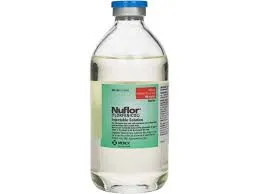
Okt . 22, 2024 12:29 Back to list
Exploring the Uses and Benefits of Florfenicol in Veterinary Medicine and Animal Health
Florfenicol An Overview of Its Use and Importance in Veterinary Medicine
Florfenicol is a broad-spectrum antibiotic that belongs to the phenicol class of antibiotics. This medication is particularly significant in veterinary medicine due to its efficacy against a wide range of bacterial infections in animals. Initially developed for use in livestock, florfenicol has gained prominence over the years for its effectiveness in treating respiratory diseases in both food-producing and companion animals.
Mechanism of Action
Florfenicol works by inhibiting bacterial protein synthesis. It binds to the 50S subunit of the bacterial ribosome, preventing the formation of peptide bonds. As a result, it effectively halts bacterial growth and reproduction. Florfenicol exhibits bacteriostatic properties against a variety of gram-positive and gram-negative bacteria, making it a versatile antibiotic choice. This mechanism is similar to that of chloramphenicol, but florfenicol has been modified to improve its safety profile and spectrum of activity.
Therapeutic Use
In veterinary practice, florfenicol is primarily used to treat infections caused by susceptible bacteria, particularly those that lead to respiratory diseases in cattle, swine, and poultry
. For example, it is effective in managing shipping fever in cattle and pneumonia in pigs, both conditions that can significantly impact livestock health and productivity. In addition to its respiratory applications, florfenicol has been used to treat infections in various species, including dogs and cats, especially those resulting from soft tissue injuries or surgical procedures.Regulatory Approval and Use Restrictions
florfenicol

Florfenicol was first introduced for veterinary use in the United States in the late 1990s, and it has since been marketed under various trade names. Regulatory bodies, such as the U.S. Food and Drug Administration (FDA), have established guidelines for its use to mitigate the risks of antibiotic resistance and ensure food safety. As florfenicol is classified as a veterinary antibiotic, it is crucial for veterinarians and livestock producers to adhere to the prescribed withdrawal times before animals are sent for slaughter to prevent antibiotic residues in meat products.
Benefits and Advantages
One of the major advantages of florfenicol is its ability to be administered in various forms, including injectable solutions and water-soluble powders, offering flexibility for different treatment scenarios. Its long half-life allows for once-a-day dosing, which can improve adherence to treatment protocols in larger livestock operations. Furthermore, florfenicol has shown effectiveness against bacteria that are resistant to other antibiotics, providing a vital tool in the fight against antibiotic resistance.
Concerns and Challenges
Despite its benefits, the use of florfenicol is not without challenges. The potential for the development of antibiotic-resistant bacteria is a significant concern in both veterinary and human health contexts. Responsible use of florfenicol, along with other antibiotics, is essential to limit this risk. Additionally, while florfenicol has a relatively favorable safety profile, adverse reactions can occur, and careful monitoring of treated animals is necessary.
Conclusion
Florfenicol represents a valuable resource in the arsenal of veterinary medicines. Its broad-spectrum activity, combined with its effectiveness against resistant bacterial strains, makes it an indispensable tool for veterinarians working to protect animal health and ensure food safety. However, the challenges associated with antibiotic use—namely resistance and safety—underscore the need for judicious application practices. As the landscape of veterinary medicine continues to evolve, florfenicol will likely remain a key player in the management of infectious diseases in animals, contributing to the overall welfare of livestock and companion animals while supporting public health initiatives regarding antibiotic use.
-
Rough Fur Manufacturers Premium Quality & Custom Solutions
NewsMay.30,2025
-
Rumination Anomaly Solutions Trusted Factory & Supplier Expertise
NewsMay.30,2025
-
Premium Sulfafurazole Manufacturer GMP-Certified Supplier
NewsMay.29,2025
-
Trichodinids Treatment Solutions Expert Manufacturer & Supplier
NewsMay.29,2025
-
Abortion in Pregnant Animals Safe Veterinary Solutions by Top Manufacturers
NewsMay.29,2025
-
Premium Rectal Prolapse Medical Supplies Trusted Manufacturer & Supplier
NewsMay.29,2025




